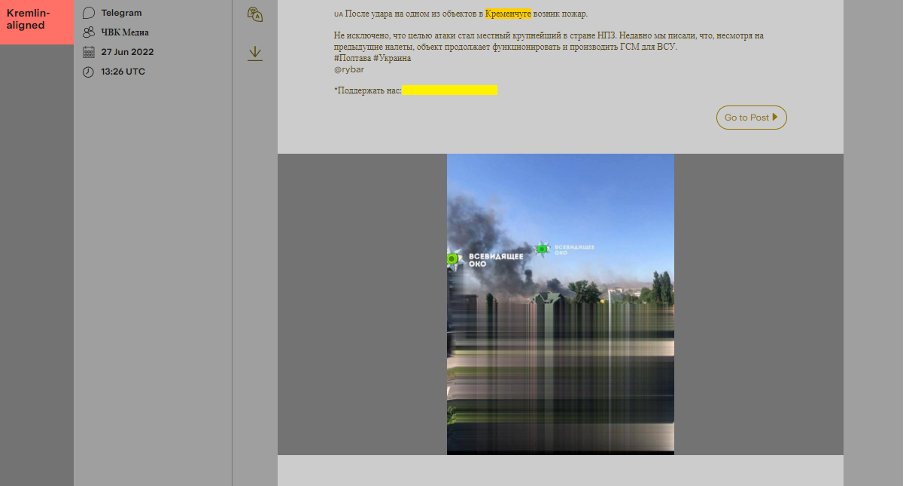
1. We’ve been tracking #Kremlin comms around the #Kremenchuk strike last week.
The dynamics—which see pro-war online ecosystems serving as a staging area for conspiracies that are ultimately adopted by the #Russia|n state—are similar to what we saw after #Bucha and #Kramatorsk.
The dynamics—which see pro-war online ecosystems serving as a staging area for conspiracies that are ultimately adopted by the #Russia|n state—are similar to what we saw after #Bucha and #Kramatorsk.
2. This cycle repeats whenever #Russia finds itself accused of atrocities.
First, there’s denial.
That then morphs into scattershot conspiracies.
Then, the theory that “sticks,” best slotting into #Russia's campaign narrative, ends up being adopted as the official line.
First, there’s denial.
That then morphs into scattershot conspiracies.
Then, the theory that “sticks,” best slotting into #Russia's campaign narrative, ends up being adopted as the official line.

3. Here’s how it panned out in #Kremenchuk.
News of the 27 June attack spread rapidly on Telegram.
Within minutes of the missile’s impact, a popular pro-#Kremlin channel reported that “something big” had been hit, sharing a photo of a smoke pile as evidence.

News of the 27 June attack spread rapidly on Telegram.
Within minutes of the missile’s impact, a popular pro-#Kremlin channel reported that “something big” had been hit, sharing a photo of a smoke pile as evidence.


4. A few key pro-#Kremlin feeds were quick to suggest that the target had been an oil refinery and, pre-empting “NATO" criticism, noted that this would make the strike “legitimate” from a military-legal perspective.
This speculation was quickly amplified across the community.


This speculation was quickly amplified across the community.



5. When images emerged showing it was a shopping centre, not a refinery, that had been hit, #Kremlin-aligned influencers adjusted their approach and went on the offensive.
This is when conspiracy theories began proliferating at scale.
This is when conspiracy theories began proliferating at scale.

6. Some immediately suggested that the whole thing was a staged psyop (like #Bucha purportedly was).
“First footage from the impact site in #Kremenchuk is published by #Zelensky an hour later,” one user wrote, “Should there be further explanation? #Bucha and #Kramatorsk 2.0.”

“First footage from the impact site in #Kremenchuk is published by #Zelensky an hour later,” one user wrote, “Should there be further explanation? #Bucha and #Kramatorsk 2.0.”


7. This “#Bucha 2.0” narrative took off quickly.
Within 90 minutes of the strike, the idea that it had been staged or somehow falsified was becoming conventional wisdom.
Like with #Bucha, these theories were pinned to just a handful of pieces of “evidence.”


Within 90 minutes of the strike, the idea that it had been staged or somehow falsified was becoming conventional wisdom.
Like with #Bucha, these theories were pinned to just a handful of pieces of “evidence.”



8. Pro-#Kremlin feeds searched for possible “clues” to support their theories.
One of the main claims was that there were too many military-aged men at the site for it to be a real shopping mall.
Instead, they held, it had actually been a secret government facility all along.
One of the main claims was that there were too many military-aged men at the site for it to be a real shopping mall.
Instead, they held, it had actually been a secret government facility all along.

9. These theories metastasised with time.
So, when #Russia, at the #UN later that evening, suggested that #Kremenchuk was “a new, #Bucha-style provocation,” it was merely lending official weight to a narrative that had already emerged, propagated, and matured informally online.
So, when #Russia, at the #UN later that evening, suggested that #Kremenchuk was “a new, #Bucha-style provocation,” it was merely lending official weight to a narrative that had already emerged, propagated, and matured informally online.

10. When denying what had happened, #Russia|n officials could point to the countless reports that had emerged on pro-#Kremlin social media, even though these were all weakly evidenced.
Here, it's quantity that matters most, not quality or reliability.
Here, it's quantity that matters most, not quality or reliability.

11. Thus, the #Kremlin can rely on strategically primed and ideologically aligned audiences to propagate defensive disinformation in its favour.
It did so in the context of #Bucha, #Mariupol, and #Kramatorsk - and now #Kremenchuk too.
It did so in the context of #Bucha, #Mariupol, and #Kramatorsk - and now #Kremenchuk too.
https://twitter.com/Ex_Trac/status/1510974341453910017
12. Whenever #Russia|n forces overreach, the war narrative remains coherent, even if that means relying on outlandish, disprovable claims.
It’s happened lots before and it’s something we’ll be sure to see more of.
Visit extrac.io for more information on our work.
It’s happened lots before and it’s something we’ll be sure to see more of.
Visit extrac.io for more information on our work.
• • •
Missing some Tweet in this thread? You can try to
force a refresh














